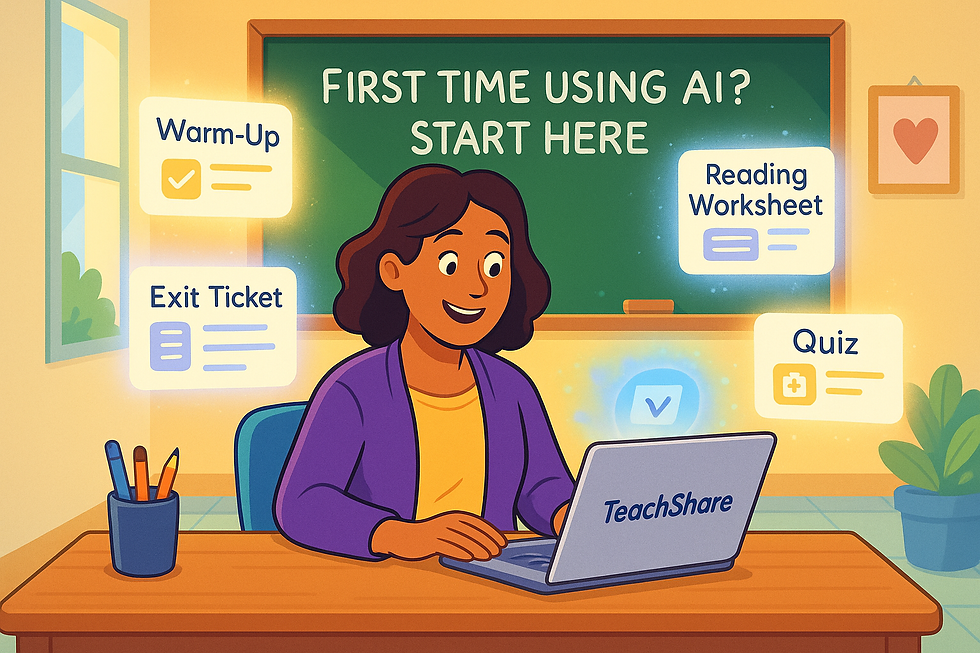How I Create Differentiated Worksheets in Under 10 Minutes with AI
- Tara Ellison
- Jun 28
- 4 min read

Grab your morning (or afternoon) coffees, and let me tell you how I created amazing worksheets in UNDER 10 MINUTES with AI. Let me be totally honest, differentiating used to be my biggest time sink as a teacher. As a SPED and inclusion educator, I’m constantly juggling accommodations, IEP goals, varied reading levels, and classroom pacing, all while making sure the content is meaningful, aligned, and accessible to my students. So when I first heard about AI tools that “make worksheets,” I quite literally rolled my eyes. But this year, I gave TeachShare a try. And it actually worked. I’m now able to generate differentiated worksheets in under 10 minutes that are tailored to my learners without compromising instructional value. Here’s how I do it, and why it’s become one of my go-to SPED lesson planning tools.
Step 1: Start with the Basics
TeachShare’s interface is genuinely built with teachers in mind. No long prompts. No weird formatting. Just straight-up intuitive planning.
Here’s all I had to do:
Topic: “Text Features in Informational Texts”
Grade Level: 4th Grade
Lesson Phase: Practice and Review
Boost: I selected the Scaffolding Boost (perfect for my ELL students)

That’s it. Within seconds, I had a ready-to-use worksheet complete with leveled tasks, visual models, and sentence frames. The platform took care of everything, and I still had time to drink my warm cup of coffee while it generated.
Step 2: Choose the Right “Boost”
TBH most platforms promise differentiation, but few deliver it in a way that feels intentional and teacher-informed. TeachShare’s Boosts weren’t just marketing fluff. Each one actually aligned with how I plan for my different learners in the classroom.
Scaffolding Boost: This was a game-changer for my SPED and ELL students. It gave me sentence frames, visual models, and step-by-step guidance built right into the worksheet. I didn’t need to spend extra time breaking things down—it did it for me, in a way that felt natural and respectful of student needs.
Discourse Boost: When I wanted to push my high-flyers into deeper thinking, this boost structured the conversations with Socratic prompts, turn-and-talks, and reflection spaces. It emphasized peer learning and perspective-taking, which was especially helpful in our Social Studies unit.
Inquiry Boost: I used this during science and WOW. The prompts helped students form their own questions and draw conclusions from data. It made the worksheet feel like an open investigation, not just a set of tasks. My kids were actually excited to figure things out.
Gradual Release Boost: This is perfect for multi-step skills. It built out the “I do, we do, you do together, you do alone” model right into the task flow. It felt like I had an instructional coach embedded in the worksheet. It gave my students the confidence to go from modeling to independent practice seamlessly.
Metacognition & Self-Regulation Boost: This one blew me away. It added goal-setting checklists and reflection prompts that helped my learners take ownership of their progress. It wasn’t just about content. It was about building student awareness.
Game-Based Learning Boost: Need to hook students with a challenge? This one’s for you. It gave me quiz-style activities and feedback loops that made review days feel more like brain games. My students were so engaged, they forgot they were practicing.

Step 3: Customize On the Spot
Here’s the game-changer: you can chat directly with the AI to edit or enhance your worksheet.
Some of my real messages to the AI:
“Can you simplify the language on question 2?”
“Add visuals for vocabulary words.”
“Make this version suitable for a student reading at a 2nd grade level.”
The AI listens, revises, and maintains the layout perfectly. No weird formatting issues. No saving and reopening in another tool. It’s all in-platform.

Step 4: Export, Assign, or Print
Once my worksheet is set, I have flexible options:
Export as a printable PDF (great for small group stations)
Assign directly to Google Classroom (auto-graded if it’s a quiz!)
Save and re-use or tweak later
And every worksheet comes with a built-in teacher guide that outlines objectives, suggested pacing, and differentiation strategies which has made observations a breeze.

Real Examples from My Classroom
Reading comprehension worksheet at three levels: included simplified text, vocabulary box, and a higher-order thinking question, all generated in under 5 minutes.
Math review with scaffolds like number lines, visuals, and word banks for my students with dyscalculia.
Science vocabulary activity modified for ELLs using sentence frames, native language translation slots, and comprehension visuals.
Why This Has Changed Everything
As a special education teacher, I’m used to spending hours tailoring materials. Now, I’m spending minutes, and still giving students exactly what they need. What used to take me 30+ minutes per worksheet to differentiate manually, now takes me under 10 minutes with TeachShare. And the quality? Honestly better than what I used to patch together from a dozen resources.
Final Thoughts: Real Differentiation, Less Burnout
Differentiation is essential, but it doesn’t have to drain us. Thanks to TeachShare, I can now focus more on student relationships and small group instruction, knowing my materials are already targeted, accessible, and standards-aligned. If you’re a SPED teacher, ELL support teacher, or just juggling a multi-level classroom, I highly recommend giving this tool a try. It’s the best AI tool I’ve found for differentiated worksheets, and it’s finally made personalized planning feel… manageable.



Comments